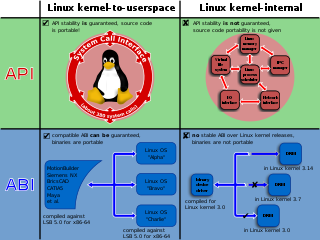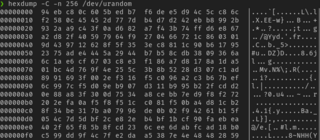Related Research Articles

In computing, the Executable and Linkable Format is a common standard file format for executable files, object code, shared libraries, and core dumps. First published in the specification for the application binary interface (ABI) of the Unix operating system version named System V Release 4 (SVR4), and later in the Tool Interface Standard, it was quickly accepted among different vendors of Unix systems. In 1999, it was chosen as the standard binary file format for Unix and Unix-like systems on x86 processors by the 86open project.
In computing, a core dump, memory dump, crash dump, storage dump, system dump, or ABEND dump consists of the recorded state of the working memory of a computer program at a specific time, generally when the program has crashed or otherwise terminated abnormally. In practice, other key pieces of program state are usually dumped at the same time, including the processor registers, which may include the program counter and stack pointer, memory management information, and other processor and operating system flags and information. A snapshot dump is a memory dump requested by the computer operator or by the running program, after which the program is able to continue. Core dumps are often used to assist in diagnosing and debugging errors in computer programs.

The Netwide Assembler (NASM) is an assembler and disassembler for the Intel x86 architecture. It can be used to write 16-bit, 32-bit (IA-32) and 64-bit (x86-64) programs. It is considered one of the most popular assemblers for Linux and x86 chips.

In computing, a system call is the programmatic way in which a computer program requests a service from the operating system on which it is executed. This may include hardware-related services, creation and execution of new processes, and communication with integral kernel services such as process scheduling. System calls provide an essential interface between a process and the operating system.

Version 7 Unix, also called Seventh Edition Unix, Version 7 or just V7, was an important early release of the Unix operating system. V7, released in 1979, was the last Bell Laboratories release to see widespread distribution before the commercialization of Unix by AT&T Corporation in the early 1980s. V7 was originally developed for Digital Equipment Corporation's PDP-11 minicomputers and was later ported to other platforms.

DragonFly BSD is a free and open-source Unix-like operating system forked from FreeBSD 4.8. Matthew Dillon, an Amiga developer in the late 1980s and early 1990s and FreeBSD developer between 1994 and 2003, began working on DragonFly BSD in June 2003 and announced it on the FreeBSD mailing lists on 16 July 2003.

Unix System V is one of the first commercial versions of the Unix operating system. It was originally developed by AT&T and first released in 1983. Four major versions of System V were released, numbered 1, 2, 3, and 4. System V Release 4 (SVR4) was commercially the most successful version, being the result of an effort, marketed as Unix System Unification, which solicited the collaboration of the major Unix vendors. It was the source of several common commercial Unix features. System V is sometimes abbreviated to SysV.

In some operating systems, including Unix-like systems, a pseudoterminal, pseudotty, or PTY is a pair of pseudo-device endpoints (files) which establish asynchronous, bidirectional communication (IPC) channel between two or more processes.

In Unix-like operating systems, /dev/random and /dev/urandom are special files that serve as cryptographically secure pseudorandom number generators (CSPRNGs). They allow access to a CSPRNG that is seeded with entropy from environmental noise, collected from device drivers and other sources. /dev/random typically blocked if there was less entropy available than requested; more recently it usually blocks at startup until sufficient entropy has been gathered, then unblocks permanently. The /dev/urandom device typically was never a blocking device, even if the pseudorandom number generator seed was not fully initialized with entropy since boot. Not all operating systems implement the same methods for /dev/random and /dev/urandom.
W^X is a security feature in operating systems and virtual machines. It is a memory protection policy whereby every page in a process's or kernel's address space may be either writable or executable, but not both. Without such protection, a program can write CPU instructions in an area of memory intended for data and then run those instructions. This can be dangerous if the writer of the memory is malicious. W^X is the Unix-like terminology for a strict use of the general concept of executable space protection, controlled via the mprotect system call.

The file command is a standard program of Unix and Unix-like operating systems for recognizing the type of data contained in a computer file.
The proc filesystem (procfs) is a special filesystem in Unix-like operating systems that presents information about processes and other system information in a hierarchical file-like structure, providing a more convenient and standardized method for dynamically accessing process data held in the kernel than traditional tracing methods or direct access to kernel memory. Typically, it is mapped to a mount point named /proc at boot time. The proc file system acts as an interface to internal data structures about running processes in the kernel. In Linux, it can also be used to obtain information about the kernel and to change certain kernel parameters at runtime (sysctl).

A free and open-source graphics device driver is a software stack which controls computer-graphics hardware and supports graphics-rendering application programming interfaces (APIs) and is released under a free and open-source software license. Graphics device drivers are written for specific hardware to work within a specific operating system kernel and to support a range of APIs used by applications to access the graphics hardware. They may also control output to the display if the display driver is part of the graphics hardware. Most free and open-source graphics device drivers are developed by the Mesa project. The driver is made up of a compiler, a rendering API, and software which manages access to the graphics hardware.
In computing, a dynamic linker is the part of an operating system that loads and links the shared libraries needed by an executable when it is executed, by copying the content of libraries from persistent storage to RAM, filling jump tables and relocating pointers. The specific operating system and executable format determine how the dynamic linker functions and how it is implemented.
In computer security, executable-space protection marks memory regions as non-executable, such that an attempt to execute machine code in these regions will cause an exception. It makes use of hardware features such as the NX bit, or in some cases software emulation of those features. However, technologies that emulate or supply an NX bit will usually impose a measurable overhead while using a hardware-supplied NX bit imposes no measurable overhead.
A kernel is a component of a computer operating system. A comparison of system kernels can provide insight into the design and architectural choices made by the developers of particular operating systems.
The Portable C Compiler is an early compiler for the C programming language written by Stephen C. Johnson of Bell Labs in the mid-1970s, based in part on ideas proposed by Alan Snyder in 1973, and "distributed as the C compiler by Bell Labs... with the blessing of Dennis Ritchie."

Fiwix is an operating system kernel based on the UNIX architecture and fully focused on being POSIX compatible. It is designed and developed mainly as a hobbyist operating system, but it also serves for educational purposes. It runs on the i386 hardware platform and is compatible with a good base of existing GNU applications. It follows the UNIX System V application binary interface and is also mostly Linux 2.0 system call ABI compatible.
GNU variants are operating systems based upon the GNU operating system. According to the GNU project and others, these also include most operating systems using the Linux kernel and a few others using BSD-based kernels.
ptrace is a system call found in Unix and several Unix-like operating systems. By using ptrace one process can control another, enabling the controller to inspect and manipulate the internal state of its target. ptrace is used by debuggers and other code-analysis tools, mostly as aids to software development.
References
- ↑ Ritchie (1993): "Thompson's PDP-7 assembler outdid even DEC's in simplicity; it evaluated expressions and emitted the corresponding bits. There were no libraries, no loader or link editor: the entire source of a program was presented to the assembler, and the output file—with a fixed name—that emerged was directly executable. (This name, a.out, explains a bit of Unix etymology; it is the output of the assembler. Even after the system gained a linker and a means of specifying another name explicitly, it was retained as the default executable result of a compilation.)"
- ↑ Wood, Rupert (8 April 2002). "What to do with a.out". gcc-help (Mailing list). Retrieved 28 April 2007.
- 1 2 "Linux Kernel Finally Deprecating A.out Support". Phoronix. Retrieved 1 September 2020.
- 1 2 "Linux Plans To Stop Building a.out Support On Alpha & M68k To See If Anyone Cares - Phoronix". www.phoronix.com. Retrieved 25 August 2024.
- 1 2 "Linux 5.19 Finally Removes Obsolete x86 a.out support - Phoronix". www.phoronix.com. Retrieved 25 August 2024.
- ↑ Ritchie, Dennis (3 November 1971). a.out – assembler and link editor output (PDF). Bell Labs . Retrieved 24 November 2006.
- ↑ "a.out page from Section 5 of the unix 8th manual". man.cat-v.org. Retrieved 12 October 2022.
- ↑ Barlow, Daniel (14 July 1996). "The Linux ELF HOWTO (v1.29)". Archived from the original on 13 July 2004. Retrieved 28 March 2008.
- ↑ Drepper, Ulrich (20 August 2006). How To Write Shared Libraries (PDF) (Technical report). 4.0. Section 1.1 (A Little Bit of History). Archived (PDF) from the original on 16 June 2007. Retrieved 20 June 2007.
When introducing shared libraries certain design decisions had to be made to work in the limitations of a.out. (...) For all these reasons and more, Linux converted early on to using ELF (Executable Linkage Format) as the binary format.
- ↑ Petkov, Borislav (5 March 2019). "x86: Deprecate a.out support" . Retrieved 5 March 2019.
Linux supports ELF binaries for ~25 years now. a.out coredumping has bitrotten quite significantly and would need some fixing to get it into shape again but considering how even the toolchains cannot create a.out executables in its default configuration, let's deprecate a.out support and remove it a couple of releases later, instead.
- ↑ Biederman, Eric W. (9 March 2022). "a.out: Stop building a.out/osf1 support on alpha and m68k" . Retrieved 25 August 2024.
Let's see if anyone cares about a.out support on the last two architectures that build it, by disabling the build of the support in Kconfig.
- ↑ Petkov, Borislav (11 April 2022). "x86: Remove a.out support" . Retrieved 25 August 2024.
Commit eac616557050 ("x86: Deprecate a.out support") deprecated a.out support with the promise to remove it a couple of releases later. That commit landed in v5.1. Now it is more than a couple of releases later, no one has complained so remove it.
- ↑ Lucas, Michael W. (2019). Absolute FreeBSD : the complete guide to FreeBSD (3rd ed.). San Francisco. p. 408. ISBN 9781593278922.
{{cite book}}: CS1 maint: location missing publisher (link) - ↑ Youngdale, Eric (1 April 1995). "The ELF Object File Format: Introduction". Archived from the original on 10 March 2009. Retrieved 6 May 2012.
(...) it is not impossible to design shared library implementations that work with a.out. The current Linux shared libraries are certainly one example; another example is SunOS-style shared libraries which are currently used by BSD-du-jour. SunOS-style shared libraries contain a lot of the same concepts as ELF shared libraries (...)
- ↑ "BSD Myths". Archived from the original on 17 April 2007. Retrieved 10 April 2007.
There were no pressing reasons to switch earlier. In particular, FreeBSD did not (and does not) have the problems building shared libraries that spurred the Linux conversion from a.out to ELF.
- Ritchie, Dennis M. (20–23 April 1993). The Development of the C Language. The Second ACM SIGPLAN History of Programming Languages Conference (HOPL-II). Cambridge, MA: ACM. pp. 201–208. doi:10.1145/154766.155580. ISBN 0-89791-570-4.